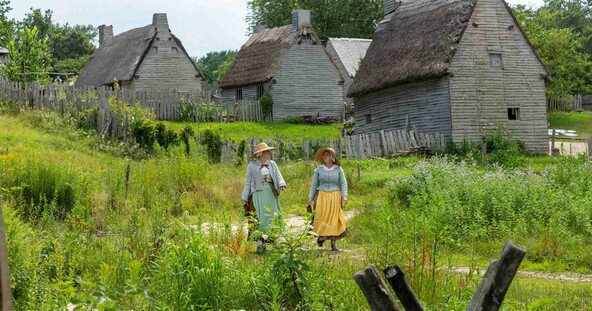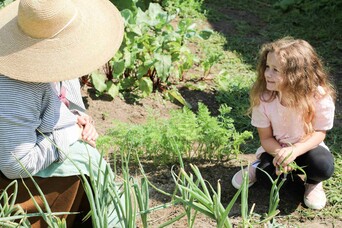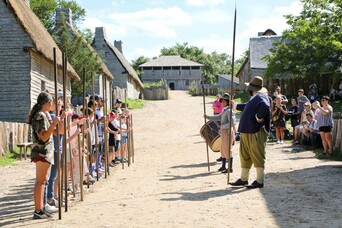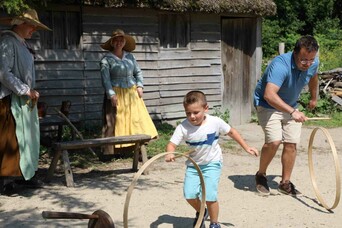
17th-Century English Village
Welcome to the 17th Century! Plymouth Colony comes to life in our recreation of early Plymouth, complete with timber-framed houses furnished with reproductions of the types of objects that the Pilgrims* owned, aromatic kitchen gardens, and heritage breeds livestock. Spend some time exploring! When you encounter someone wearing historical clothing, they are playing the role of an actual inhabitant of Plymouth Colony. They will talk about historical events and lifeways as if they are happening in the present, and will express their hopes, fears, and viewpoints. Modern-day guides will help you better understand the 1600s.
*Although not commonly used until the 19th century, for the sake of convenience, we often use the popular term Pilgrim when talking about the Plymouth Colonists.
What will you do at the 17th-Century English Village?

A goodwife, or Pilgrim woman, might ask you to help her pound corn. You might visit the garden with her or help her make sage and salt toothpaste.

You may be called upon to participate in a muster drill! Captain Miles Standish will teach you to follow his commands. Learn about 17th-century defense, and how the Pilgrims prepared themselves to keep their town safe.

Play a Pilgrim game! The Pilgrims worked very hard, but they had some time for recreation, especially activities that made them exercise their minds.
Frequently Asked Questions
No. The original site is in present-day Plymouth Center, located 2.5 miles north of the re-created 17th-Century English Village. There are a number of historical markers on Leyden Street that identify the location of the first houses. The houses in the Museum’s 17th-Century English Village are re-creations of what those first houses may have looked like.
Most visitors spend at least 2 hours. On your self-guided visit, you may tour the Village and enter about a dozen re-created buildings. In many of these places you will find role players at work.
Not in every house. Much of the work in a 17th-century farming community took place out of doors, so you will find costumed staff in the fields, gardens, and other work areas of the Village as well as in the houses. When you do encounter an empty house, feel free to explore the interior and garden.
Occasionally. On weekends and during the summer, children of staff members sometimes portray children who lived in Plymouth.
Possibly. Because there are fewer role players than there were English colonists, not all the colonists are represented in the 17th-Century English Village. Your ancestor may not be portrayed but you will find that other role players can often provide you with the scoop on your great-great-great-great-grandmother or grandfather!
The Museum sites are open through almost all weather extremes. (We have been known to close early because of a hurricane or two.) Please dress appropriately for the weather, and you should have an enjoyable time.
On rainy days the rhythm of the 17th-Century English Village changes. Much of the outdoor work cannot be done, so the role players can be found inside their houses and sheltered workplaces. Guests tell us that these rainy days have their own cozy charm.
On extremely hot summer days, you will see less activity in the town as everyone, role players and guests alike, head for the shade. This is not just a concession to modern comfort, however. Under such conditions, the English colonists were likely to limit hard work to the cooler early morning and evening hours.
The English colonists did not specifically label themselves in the letters, books, and documents they wrote. Sometimes they referred to themselves as Planters (colonial farmers) to distinguish themselves from the Adventurers (men and women who financed the colony).
The word “pilgrim” was used once in the surviving writings of the early colonists. More than 20 years after the arrival of Mayflower, William Bradford wrote about the church's departure from Leiden, Holland to America. Referring to Scripture, as he often did, he wrote; "they knew they were pilgrims," in reference to Hebrews xi.13-16. Then, as now, a pilgrim is someone on a journey with a religious or moral purpose.
Bradford did not repeat the reference nor did he use "Pilgrim" as a label or title for the English in Plymouth Colony. More than 150 years later, this quotation was applied to everyone in Plymouth Colony, including those who were not part of the Leiden congregation. The name gained popularity in the 1800s and remains in common usage today.
Museum guests often question the unusual spelling of Plymouth in Plimoth Patuxet. Plimoth is an old-fashioned spelling used by Governor William Bradford within his history of the colony, Of Plymouth Plantation. This spelling was adopted to differentiate the Museum from the modern town of Plymouth. There were no rules for the spelling of English words in the early 17th century, and each writer did as he or she pleased, phonetically spelling the word as seemed fit – sometimes differently on a single page. Plymouth is spelled a number of ways in colonial documents, including Plymouth, Plimouth, Plymoth, and Plimoth. When Plimoth Plantation was founded, it was decided to use Governor Bradford's most common usage, Plimoth.
Banner Image by Kathy Tarantola Photography